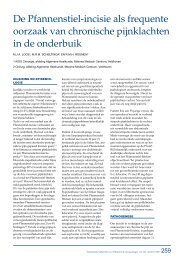Surgical management of chronic inguinal pain syndromes - Liespijn
Surgical management of chronic inguinal pain syndromes - Liespijn
Surgical management of chronic inguinal pain syndromes - Liespijn
You also want an ePaper? Increase the reach of your titles
YUMPU automatically turns print PDFs into web optimized ePapers that Google loves.
on <strong>chronic</strong> <strong>pain</strong>. Presence <strong>of</strong> <strong>chronic</strong> <strong>pain</strong> was the dependent variable whereas age,follow-up duration, priority <strong>of</strong> CD, number <strong>of</strong> Pfannenstiel incisions, numbness, and scarlength were used as independent variables. The multivariate model was constructedby backward stepwise selection with entry testing based on significance <strong>of</strong> scorestatistics. CD priority was assessed in a multivariate analysis with CD patients only. Thelimit <strong>of</strong> statistical significance was set at p=0.05 (two-sided). Analysis was performedusing the Statistical Package for the Social Sciences (SPSS), Windows version 12.0.1RESULTSFigure 1 Schematic drawing in questionnaire that women used for <strong>pain</strong> localisation with corresponding results.(n=205, missing data in 18 patients). Pain distribution showed in percentages: at the right end <strong>of</strong> the scar, left end, entirescar, middle <strong>of</strong> the scar and diffusely in the lower abdomen. 30 patients reported <strong>pain</strong> at both lateral ends <strong>of</strong> the scar.Mean incision length, cm (SD= standard deviation) = 13.5 (3.4).QuestionnaireA total <strong>of</strong> 872 CD’s and 95 AH’s using a Pfannenstiel approach was performed during thetwo year time period. A patient flow chart is depicted in Figure 2. There were 866 post-Pfannenstiel patients who were eligible for this study that received a questionnaire.Eventually, 690 patients returned the questionnaire (response rate 690/866, 80%).Demographic and clinical details <strong>of</strong> both responders as well as non-responders arelisted in table 1. Except for priority <strong>of</strong> CD, these two groups were comparable. A CD wasperformed in more than 90% <strong>of</strong> the women, and an average CD patient was approximately15 years younger compared to an abdominal hysterectomy patient (35 vs. 50yrs, p





